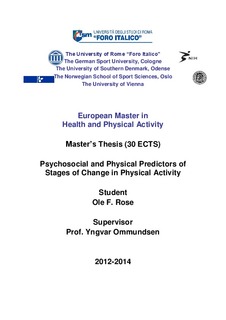| dc.description.abstract | Background: The need of effective intervention programs for promoting physical activity is
an important aspect in public health practice. Psychosocial factors’ role on behavior change
have received much attention in the exercise domain, and seems to be central in determining
people’s exercise habits. In terms of exercise adherence, there seems to rule uncertainty in
determining long-time effects of psychosocial status in people’s day-to-day life in a noninterventional
setting. Despite common awareness of the negative consequences associated
with increased BMI and poor psychological health for exercise adherence, the relative
importance of these factors compared to psychosocial status seems to be unclear. The
contributions of psychosocial factors for predicting physical activity status and progression in
a natural context remains unknown, thus warranting the current research.
Purpose: The primary purpose of this study was: 1) investigate to what extent psychosocial
factors (including psychological health) and BMI could predict status of physical activity in a
non-interventional setting. 2) investigate to what extent psychosocial factors (including
psychological health) and BMI predict a change (progression) of physical activity in a noninterventional
setting.
Methods: A sample consisting of 565 inhabitants from a low socio-economic status
environment in Oslo, Norway, acting as control group in the “Romsaas in Motion”
intervention study, provided questionnaire data in 2000 (time 1) and 2003 (time 2). BMI was
measured at time 1, and the questionnaires were identical at both surveys. A valid and reliable
tool, stages of change of physical activity, was applied to detect levels of physical activity.
BMI and psychosocial predictor indices derived from different theories measured at time 1
were analyzed to detect whether or not they could predict physical activity status and/or
progression at time 2.
Results: Psychosocial indices at time 1 predicted 28 % of stages of change status at time 2
(controlled for BMI and psychological health). Time 1 self-efficacy in overcoming
psychological barriers, affective attitude towards physical activity, and physical activity
identity was significant predictors of time 2 status in physical activity. Controlling for BMI
and psychological health, psychosocial factors predicted 4 % of progression in physical
activity stages of change from time 1 to time 2. Affective attitude towards physical activity
5
and physical activity identity stood out as significant predictors of physical activity stage of
change progression.
Conclusion: If people find physical activity easy, pleasant, and interesting at some point in
their adult life, it will likely influence their future physical activity. People who identify
themselves as exercisers, who cares about their body, see themselves as interested in physical
activity, and interested in being physical fit, also enhance the possibility of being more
physical active than people with low perceived physical activity identity. Likewise, people
who believe they can overcome barriers of a psychological nature, such as being tired,
stressed or worried are likely to belong to a higher stage of change in physical activity in the
future. This is true regardless of BMI status and psychological health. However, psychosocial
factors as well as BMI and psychological health, only explained a small portion of physical
activity progression from time 1 to time 2. | nb_NO |
